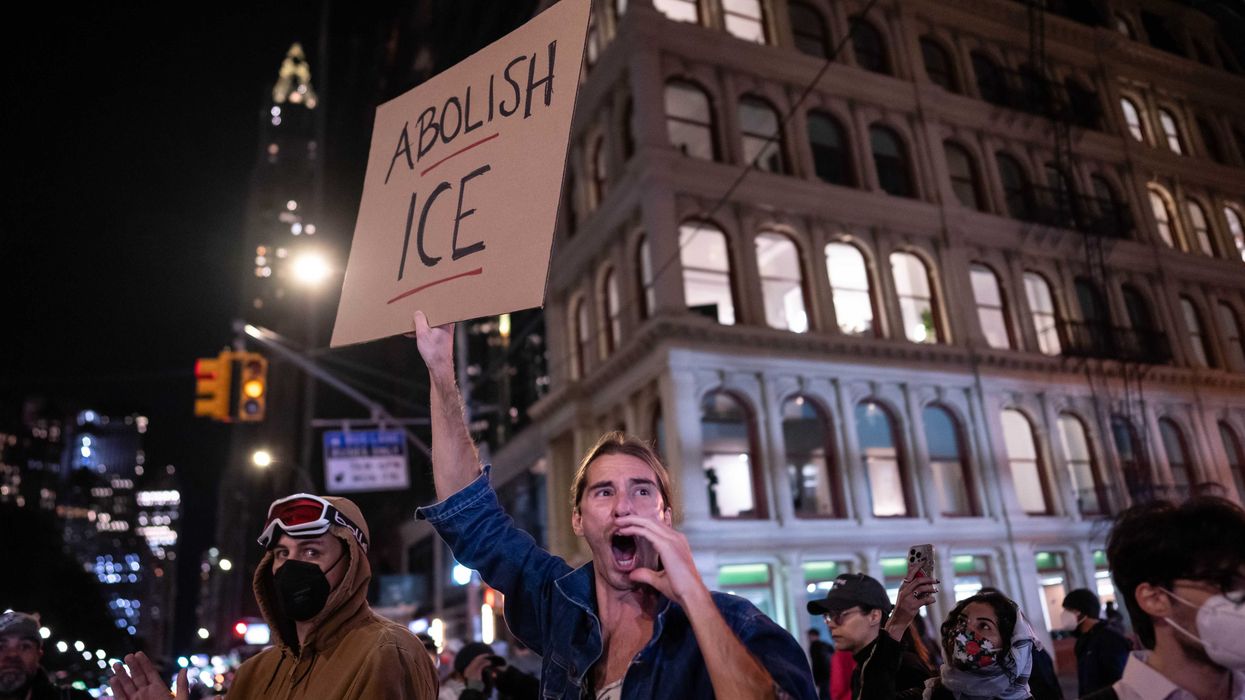Do you remember being a kid and running wild in the neighborhood? Not anymore! In fact, now you can get in trouble for something called “free range parenting.” A Maryland family found this out the hard way when their kids were taken into custody by the police after they were found at the park without adult supervision. On radio this morning, Glenn spoke with Lenore Skenazy, founder of FreeRangeKids.com, about this story and why and how parents should start letting their kids grow without constant supervision.
Below is a rush transcript of this segment:
GLENN: Lenore Skenazy, she is a woman who started freerangekids.com. And she -- I believe, Lenore, you're the one who coined this phrase.
LENORE: Yeah, I am. Hi.
GLENN: How are you?
LENORE: Very good. Kind of exhausted.
GLENN: You were a woman who was in trouble with the Department of Children and Families. When was it? Back in January?
LENORE: It was 2008. I have to say that I wasn't actually in trouble with the authorities. I was in trouble with the media because I let my 9-year-old ride the subway alone, which is something he had been asking to do. And my husband and I decided he was ready and so were we. So I wrote a column after he had taken the little trip. And I called it why I let my 9-year-old ride the subway alone here in New York City. Two days after the column appeared, I was on the Today Show, MSNBC, Fox News, NPR, you name it. And being decried as America's worst mom because how dare you let your children do anything alone. So I started free-range kids, my blog that weekend to explain that I'm very -- I say I'm a nervous mom. I love car seats. Seat belts. Mouth guards. If you have a birth -- you know, a baby shower, the gifts I always bring, I'm so boring, predictable, I bring a fire extinguisher. I believe in safety. I just don't think our kids need a security detail every time they leave the house. And, apparently, that is controversial to this day.
GLENN: So tell me about the stranger danger myth. Because we were trying to figure this out. We were talking about this yesterday. And we were like, nothing is -- this is -- things have gotten better since we were kids, and none of us would consider doing it. And we all know that it's unreasonable that we should.
LENORE: Right. That we should let our kids go outside and play?
GLENN: Yes. Pat wouldn't let his daughter -- he like had a heart attack. She was like, dad, I want to go literally half a block down to the lake. He was like, no. No. No.
PAT: She's 15.
GLENN: She's 15. He let her do it. But he freaked out.
LENORE: Wow. Well, first of all, congratulations. I'm glad you let it happen.
PAT: Yeah. Thank you. Very proud.
LENORE: What I've noticed over the years is that once we let our kids do something on their own, provided they're not arrested by the police, let them walk to school, let them make dinner, let them ride their bike to the library and back, generally you end up so proud from just that one incident, seeing your kid being this competent blossoming young man and woman instead of little vulnerable baby that we are sort of encouraged to think of our kids as. That pride allows to you give them even more freedom. And that's always been the way it has been with human beings. You know, you see your human growing up. It's bittersweet. This is the little girl I carried. Not anymore. But, look, she's growing up.
So if you're asking how did we get to this point where all of us who played outside until the street lights came on won't let our kids do that until they're 29.
GLENN: Wait. Wait. You should do it at 29?
STU: Thirty-five.
LENORE: With an escort, of course. And by escort, I mean, police escort.
STU: Okay.
LENORE: The way we got to this point is that we've had really fear shoved down our throats for the last 20 or 30 years, ever since -- you know, there's a bunch of reasons. But the media discovered, first with the Etan Patz case and then with the very sad -- equally sad Adam Walsh case, that there's no story that grips viewers, that gets eyeballs, that gets ratings as that of a white middle class child who is abducted.
PAT: So, Lenore, how did you break free of that? Because it sounds like a frightening thing to let your 9-year-old ride the subway in New York.
GLENN: One, you stop listening to WOR TV, where it says, it's 10 o'clock. Do you know where your children are?
PAT: My gosh. No, he's on the subway.
Was it a white-knuckled thing? Were you scared the whole time he was away? Did you follow behind him at first? How did you let go like that?
LENORE: How did I let go? I think what makes me a little different is that I don't watch a lot of TV news. And I think that is very freeing. I think the reason our parents let us go -- you know, my mom let me walk to school as a kindergartener, not because she was some free-range nut who didn't care if I lived or died, but because back then -- this is how old I am. I'm probably older than you, Glenn. Back then, there was only a half hour of news at night. They just didn't spend it all talking about some horrible tragedy that happened 17 states away. And so if you're not sort of reading in every day the terrible sadness that the news is bound and determined to show you, it's a lot easier to let go. Some people say like, well, you know, you're living in a la-la land. Don't you watch the news? It's like, the news is not reality either. It's what horrible thing happened to .0001 sad percent of the population today. And if I made my decisions based on that, I could never let my kids do anything, including eat solid foods or walk down the stairs because kids die doing those things too.
GLENN: I know you're a fan of Gavin de Becker. Gavin de Becker is the protection detail that we have for my family and company. And he's a remarkable guy. And he has been involved in the rescue of children who have been kidnapped before. And he says that a child is vastly more likely to have a heart attack than to be kidnapped.
LENORE: I know.
PAT: Wow. Jeez.
GLENN: And child heart attacks are so rare that no one ever considers the risk.
LENORE: It is so hard to keep risk in perspective when all you see are the very rare, very sad stories. And we also have something that I consider kind of babyish about our society today, which is that, we demand that if something isn't 100 percent safe, 100 percent of the time, it's dangerous. I mean, we really see no gradations. This is leading us to crazy things like in Spokane. They just decided -- Spokane, Washington, they decided to do away with swings on all the playgrounds. That's because there's no guarantee that every child who swings in America for the next ten years will never fall off or, you know, hurt themselves. And it's true. We can't guarantee that. But you also can't guarantee that a kid in her bedroom won't be stolen. I mean, once in a while, something terrible happens. And if you're basing all your everyday decisions on the very worst-case scenario, you will start acting crazy like Spokane is and getting rid of all the swings. So kids don't get to go on swings at the playground anymore.
GLENN: Beyond that, when I was at the -- what is it -- the north rim. Which is the Native American side? The north rim of the Grand Canyon. Or the south rim. I can't remember. Well, the one that is not the American side. I went there. And there are no guardrails.
LENORE: Wow.
GLENN: There are no fences. It's just cliff canyon.
LENORE: Wow. That's scary.
GLENN: It was bizarre. Because it's obviously dangerous.
LENORE: Right.
GLENN: And I was talking to the guide, and I said, there are no fences. There are no guardrails or anything. And he said, no, it's not America. And I said, holy cow. And he said, but if you look at the stats, there are problems on the American side of the canyon because they put a false sense of security, and so people are like -- they'll look over the fence. And they'll fall because they're cheating death. He said, here everybody stays away from the rim. You have to be a real dummy to approach the rim.
LENORE: How fascinating.
GLENN: Yeah. It's amazing.
LENORE: So when I spoke with the head of the National Center for Missing and Exploited Children. They're the people that put the pictures of the missing kids on the milk cartons. Remember those? Made us think that kids are being snatched left and right and forgot to mention that most of them were taken in custody disputes or runaways.
But anyways, when I spoke to him, he too said that this stranger danger idea was a, quote, unquote, myth we are trying to explode. And he said something that reminds me of your Grand Canyon story which is that the safest kids are the ones who have sort of self-confidence and street smarts. And the way you get those is by doing some stuff -- again, it's called self-confidence. It's not parent-assisted confidence. So you sort of almost have to let people have some experiences in the real world, almost like get as close as they feel comfortable to the edge of that cliff without saying, you can stand here. And here's a guardrail. And here's an emergency number to call. And here's somebody watching you.
GLENN: Right.
LENORE: You must let kids have some independence if you want them to be sensible and safe. And so the idea that we're keeping kids safe by not allowing them on a sunny Sunday afternoon to play -- a 10-year-old and a 6-year-old together in their local park. And we think that that's too dangerous. If you ask me what's dangerous, it's not letting your kids play in the park.
GLENN: Lenore, hang on the phone. I want to ask you one more question. That is this, how do we handle when somebody calls 911 on our kids because they're half a block away playing by themselves. How do you not get the state involved? We'll go to that here in just a second.
LENORE: That's a great question.
GLENN: Lenore Skenazy, by the way, she speaks all over the country. And she's absolutely fantastic. If you'd like her to speak at your group, Lenorespeaks.com. Lenorespeaks.com. Or you can go to freerangekids.com.
[BREAK]
GLENN: We have Lenore Skenazy on the phone with us from Freerangekids.com talking about the story out of Silver Springs, Maryland, where these parents had their kids, ten and six, go to the park. They dropped them off at the park. It's half a block away from their house. The kids walk all the time. They're responsible kids. Somebody called 911 and said, there's no adult watching these kids. The police came, picked them up, took them to the Department of Family and Child Services, and they're now under threat of losing their kids again.
I think this is insane.
LENORE: Yes. Sorry.
GLENN: No. No.
LENORE: Listen. I think it's insane too.
GLENN: I was going to say. But, A, how do we get to the place -- because everything you've said, Lenore, I agree with. So how do we get to the point to where we can -- how do we ease into it? And then how do we stop others from calling 911, or what do we do when the state shows up and says -- because this is what they said. They were responsible for child neglect.
LENORE: Yeah. Child neglect. Like all our parents who neglected us and all we could do was go outside and play. Wow, those horrible neglectful parents. Every single parent in the '60s, '70s, and '80s, I guess, was one of those. So this is a question that I've puzzled over on a daily basis. And I've come up with a couple of ways that I think we can try to fight back the criminalization of very decent parents.
One is, I have a bill of rights. It's one sentence long. And I'm trying to get people to introduce it to a town hall meeting, to a city council meeting, to a PTA meeting. Anywhere they can. It's simply this. It's the free-range kids bill of rights. Kids and parents bill of rights. And it is: That our children have a right to some unsupervised time, and we have the right to give it to them without being arrested. It's that simple.
STU: Radical.
LENORE: We all know that we loved unsupervised time when we were growing up. We all know that if you look at the FBI statistics, crime is down today. It's not just down because we're helicoptering kids. It's down against -- the murder rate is down. And arson and burglary and assault. So these are actually safer times than when most of us were growing up. So considering that crime is down and that we know that letting kids play outside is a time-honored thing that parents have done forever, we should be able to give that to our children without threat of arrest. I think CPS exists for a reason. And you're actually harming a kid and if it's obvious and indisputable and immediate, the harm that they're in, grab those kids away from those parents. But don't grab away kids who happen to be playing at a park near their house. There's just a world of difference between those two scenarios.
GLENN: What's the second idea?
LENORE: Second idea is something I started about a month ago. It's this free thing I put on my site. You can go to it directly. It's called freerangefriend.com. And all you do is you enter your ZIP code. If you want to, you can enter the ages or genders of your kids or not. But it allows you to find other free-range parents in your neighborhood. Because one reason that people are calling 911 when they see a kid outside, is that they never see any other kids outside. It's like seeing an escaped gazelle. I just saw this thing on the street. It was small. It had pigtails. I don't know what it is.
[laughter]
Then asking the officer to catch it with the net.
GLENN: Lenore, I have to break. I have a hard network break. But I want to give that. It's freerangefriends.com?
LENORE: Freerangefriend.com.
GLENN: Okay. Freerangefriend.com. Freerangekids.com. And if you would like Lenore to come speak at one of your events, she's absolutely tremendous as you've just heard. Lenorespeaks.com. Lenore, thank you so much. God bless.
LENORE: Oh, thank you, Glenn. Thank you for having me on.

 AASHISH KIPHAYET / Contributor | Getty Images
AASHISH KIPHAYET / Contributor | Getty Images
 Harold M. Lambert / Contributor | Getty Images
Harold M. Lambert / Contributor | Getty Images Adam Gray / Stringer | Getty Images
Adam Gray / Stringer | Getty Images Anadolu / Contributor | Getty Images
Anadolu / Contributor | Getty Images